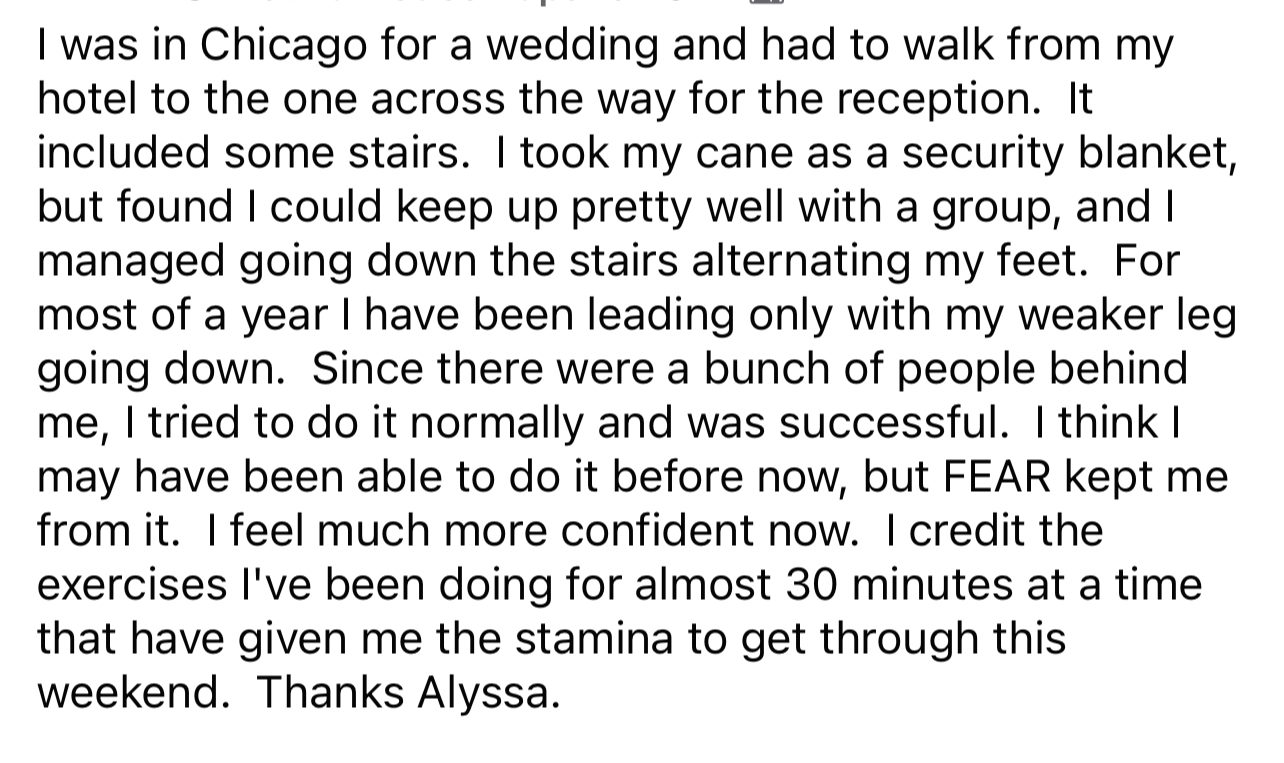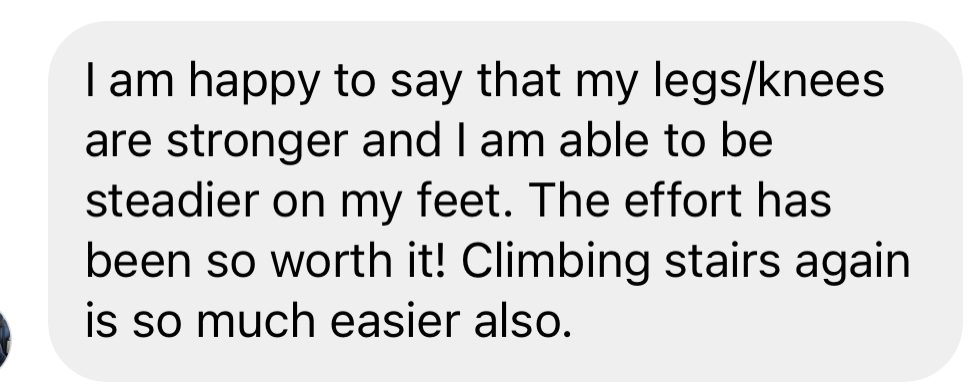Climbing stairs will not make your osteoarthritis worse. Your cartilage actually loves when you move, so climbing stairs won’t cause more damage. Stairs could, though, cause a little more irritation in your joints without the appropriate muscle support. So is stair climbing good for osteoarthritis?! Yes, if we have the right support. How do we build this support? You can build strength and stability in your knees with the right strengthening and mobility exercises which will help make getting up and down the stairs easier.
Do you dread going up and down the stairs in your home everyday?
Are you worried that each time you climb the stairs that you are making your arthritis worse?
Do you feel like you are hobbling with each step that you take?
So is stair climbing good for osteoarthritis or are the stairs actually hurting my joints?!
Are stairs bad for my knees?
If you have ever wondered this, you are in the right place!
Stairs can be your enemy if you have knee, hip, or low back arthritis. We commonly find that many people tend to avoid climbing stairs not only because of joint pain, but also fear that climbing stairs is going to make arthritis worse.
Well, is stair climbing good for osteoarthritis? Let’s take a look.
Hope for stair climbing with ease again
I wanted to first bring you hope, especially if you have stairs in your own home!
It is possible to climb stairs without pain and stiffness, even if you feel like you have already tried everything. Hear me out.
I had a recent client who never thought she would see the day of climbing stairs without having to grimace with each step because of pain from a meniscus injury.
Now, she is going up and down the stairs multiple times a day without even thinking twice about it. How nice would that be?! This is what freedom from arthritis pain feels like.
So is stair climbing bad for your knees?! Absolutely not!
Another client would feel so out of breath when climbing the stairs when he got to the top. He would also feel his back stiffen up with each step that would send his back into spasms intermittently.
Now he is gliding up the stairs to his bedroom with ease and without back pain!
So is stair climbing good for osteoarthritis? The answer is yes, especially when your joints are prepared!
Take a look at wins from members of Adventurers for Life, our flagship membership program to see what’s truly possible:




Stairs can be a great form of exercise and comes with many benefits. Research has also shown that in a group of people diagnosed with knee osteoarthritis…
“There was consistent and convincing evidence that greater stair-climbing ability was related to stronger lower limb muscles and less knee pain.”
Whitchelo et al. 2013
In order to climb stairs without pain, you need strength and stability. Muscle strength will help to support your joints and keep them happy when going up and down the stairs. Without muscular support, your joints take more stress than they are used to. This can lead to irritation. In order to benefit from stair climbing, you have to prepare your legs for the challenge.
Why is stair climbing good for arthritic joints
Stair climbing works multiple muscles at once which means more benefit in less time.
It also offers benefits to your heart health and improves your stamina, especially when climbing stairs regularly. Stairs can help you maintain single leg strength and challenge your balance, in ways that regular forward walking cannot.
According to the Harvard Alumni Health Study, climbing just 10-19 floors per week was associated with a lower mortality risk in men age 60-71. This is an important finding because even adding in a minor amount of stair climbing to your week can give you future health benefits.
Stair climbing also helps to increase the activity that you get during the day. Oftentimes with osteoarthritis, we try to avoid exercise but it turns out, exercise is great for osteoarthritis. Check out more benefits of exercise here.
Unfortunately we can’t build muscles overnight but until we do, we can use these tactics below to make stairs a little easier on your joints.
Here are 3 simple tricks you can try:
- Going down the stairs sideways. This can decrease the amount of pressure that is put on your knees and your low back.
- Going down the stairs backwards. Not necessarily the most ideal, especially in unfamiliar environments other than your own home because of your limited vision.
- Going down the stairs one at a time. This can also help, especially when you have steeper stairs. This limits the amount of force that goes through your joints.
These can give you temporary relief until you can gain more confidence and decrease your joint pain when going up and down stairs. Now let’s get to some exercises you can do in the meantime!
5 exercises to make climbing stairs easier with osteoarthritis
Now that we know stair climbing is not bad for the knees or other joints, let’s make them easier for you!
There are some simple tips we need to follow to make sure your joints are ready to climb stairs.
This is a proven system that has worked time and time again for my patients and they can work for you too. Here are the first 5 exercises that can help you unlock stair climbing power.
BUT the key is consistency and perseverance.
Let’s take a look at these exercises to make stair climbing easier with osteoarthritis.
1. Tandem band pass:
Balance is extremely important. When you are in a position that challenges your balance, your muscles have to work together to keep you upright. When they don’t work together (i.e when some muscles are stronger than others or aren’t activating as quickly) then we tend to lose our balance.
Improving your balance can help those muscles work together again to give your joint more support and thus, LESS PAIN.
Try to complete the tandem balance pass exercise using a resistance band or a household object like a pillow. Try to work up to holding for at least 30 seconds each side.
2. Step back and March
This exercise challenges your balance which is absolutely needed when you are looking to master stair climbing. If you want to prove to yourself that you can actually climb stairs, this is one you need to try.
If your knee or hip feels stiff when taking the first couple steps, this can help significantly. I would try anywhere from 10-20 reps on each side. Start out with support of the railing then as you feel comfortable, progress away from it.
3. Banded side stepping:
When trying to show your joints that stairs are not bad for arthritis, lateral movements are a must!
The muscles that help you move side to side tend to get neglected because you don’t purposefully move sideways very often. These muscles are SUPER important for stair climbing though. Working them against resistance is a great way to build strength.
Resistance bands can be extremely versatile and help you get stronger, quicker. I highly recommend you get some if you don’t have a set. Try to complete 10-20 total steps of this banded stepping exercise.
4. Front foot elevated lunge
This is one of the most important strength movements for climbing stairs without pain. Mastering the lunge is crucial to your success with getting up and down the stairs, but it can also be irritating.
This variation can help to be nicer to the knees to start. It also tends to feel good on the hips too!
Hanging onto something to start can help. If you don’t do this movement correctly, it can lead to increased knee pain.
Starting with support helps you to maintain the correct form and reduce pain levels. Imagine someone is pushing you straight down, keeping your chest up. Only go down as far as is comfortable to start. Try to complete 8-10 reps on one leg first, then switch to the other side.
5. Alternating stair taps
This exercise can seem simple but it will help to increase your heart rate and challenge your single leg balance. The goal is to be able to complete this without needing to hold onto the railing, but support may be necessary at first.
Try to complete between 20-50 of these, alternating legs. To make it a little easier, stay on the same leg to start. Switching will increase the difficulty.
SO is stair climbing good for osteoarthritis?!
The answer is YES, if we follow the right steps to keep our joints strong and healthy. We now know stairs are not bad for arthritis. Let’s summarize these tips from above so you can get on the right path to life changing pain relief. In order to reap these results, we have to take action. Without action, you will continue to irritate your knees with stairs. Relief is possible we just have to work for it.
Here are the top three things you need to do in order to master stair climbing, even with arthritic joints!
- Find a temporary way to go up and down the stairs (sideways or backwards) to make them tolerable and decrease irritation.
- Complete these exercises at least 3-4 times per week. It would be best if you could follow this sequence: Exercise 1, exercise 2, exercise 3 then repeat 1-2 more times through. If you notice pain during the exercises don’t go down as far or reduce the number of reps. You may feel some discomfort when starting new exercises but they should not cause significant pain.
Now, you don’t have to second guess if stair climbing is good for osteoarthritis. Once you make sure your joints are prepared, stairs can be a GREAT form of exercise.
Do you wish stairs were easier? Do you dread climbing up and/or down the stairs because of discomfort or pain in your joints?
Stairs can be difficult, especially if you have knee or hip osteoarthritis as well as other conditions like a meniscus injury or back pain.
Staci found herself dreading stairs after being diagnosed with knee osteoarthritis. She hated them because of all the pain she anticipated with each step. This dread also forced her to give up her love, hiking too.
She thought stairs would never be the same again. She was worried she would continue to have a hard time with stairs…forever. She also had a hard time standing for long periods of time.
Now she doesn’t dread doing the stairs. She also doesn’t feel like she is hobbling with each step or death gripping the railing.
This is HUGE, especially if you have not been getting along with the stairs for awhile. Unlocking the ability to go up and down the stairs with ease is possible, even with knee osteoarthritis.
If you’re looking for the best place to get started, the Adventurers for Life membership provides a step by step path on how to build strength in the right places and the best ways to find pain relief.
Without taking action, your knee pain could continue to make stairs extremely difficult. In just a few weeks, Staci was able to see amazing changes and that was before even starting exercise!
Find out how you can learn to tackle stair climbing again too by jumping inside the Stair Climbing Secrets below.
The longer you wait, the more out of reach stairs will become…




Alyssa Kuhn
There are affiliate links from Amazon embedded in this post that offer a small commission without any cost to you.
Disclaimer: This post is for general informational purposes only. It should not be used to self-diagnose and it is not a substitute for a medical exam, cure, treatment, diagnosis, and prescription or recommendation. It does not create a doctor-patient relationship between Dr. Kuhn and you. You should not make any change in your health regimen or diet before first consulting a physician and obtaining a medical exam, diagnosis, and recommendation. Move Well Age Well, LLC and Dr. Alyssa Kuhn, PT, DPT are not liable or responsible for any advice, course of treatment, diagnosis or any conclusions drawn, services or product you obtain through this video or site.




